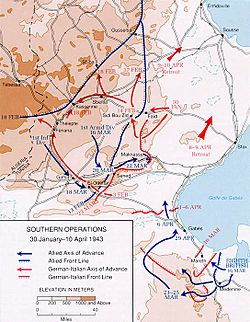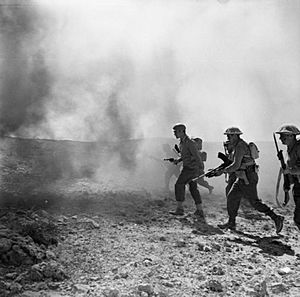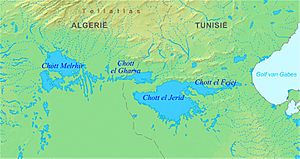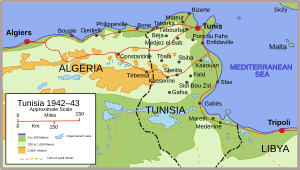Battle of Wadi Akarit facts for kids
Quick facts for kids Battle of Wadi Akarit |
|||||||
|---|---|---|---|---|---|---|---|
| Part of the Tunisia Campaign of the Second World War | |||||||
 Gabès and the Tunisian Campaign. |
|||||||
|
|||||||
| Belligerents | |||||||
|
|
|||||||
| Commanders and leaders | |||||||
| Strength | |||||||
| 3 divisions | 24,500 (estimated) | ||||||
| Casualties and losses | |||||||
| 1,289 32 tanks |
7,000 prisoners | ||||||
The Battle of Wadi Akarit was an important fight during the Second World War. It happened in Tunisia from April 6 to 7, 1943. Allied forces attacked to push back Axis forces from their strong positions along a dry riverbed called Wadi Akarit. This battle was a key part of the Tunisia Campaign.
The Gabès Gap, near the towns of Gabès and El Hamma, was a narrow passage. It was located between the sea and large, impassable salt marshes. British soldiers, especially the 51st (Highland) Infantry Division, broke through the enemy's defenses. This allowed the main Allied army to advance and defeat the Axis forces. After some strong counter-attacks, the Axis troops had to retreat. The Eighth Army, led by General Bernard Montgomery, chased them towards Tunis. They stopped when they reached new Axis defenses at Enfidaville.
Contents
Why This Battle Happened
After the Allies outflanked the Mareth Line, Axis forces moved back to Wadi Akarit. This area was north of Gabès. Erwin Rommel had seen this spot as a good place to defend. It had strong natural defenses and short supply routes to Sicily. Rommel had wanted to retreat here earlier to resist the Eighth Army.
Holding the British at Wadi Akarit would let the Axis focus on the First Army to the west. The Gabès Gap was the last good defensive spot. If the Eighth Army got past it, they could reach Sfax. Then, the First and Eighth Armies would join up.
Getting Ready for Battle
Wadi Akarit stretched from the Mediterranean Sea in the east to impassable salt marshes in the west. This meant there were no open sides for the Allies to go around. A direct attack on the prepared defenses was the only option.
The defense line followed Wadi Akarit for about 8 kilometers (5 miles). This part was impossible for tanks to cross. Then came a wider, dry riverbed. Behind it was a long hill called Djebel er Roumana. This hill was part of a line of high ground. The path to Djebel er Roumana was blocked by an anti-tank ditch. There were also more defenses to the west.
The Battle Begins
Allied troops reached Wadi Akarit on March 30. For a week, they mostly patrolled and checked the Axis defenses. Three divisions were chosen for the main attack. The 51st (Highland) Infantry Division was on the right. The 50th (Northumbrian) Infantry Division was in the center. The 4th Indian Infantry Division was on the left. Before the battle, British and American planes bombed the Axis defenses day and night.

The commander of the 4th Indian Division, Major-General Francis Tuker, suggested a different plan. He convinced General Montgomery to attack Jebel Fatnassa. This was a steep 240-meter (800-foot) hill. It was defended by Italian and German troops. The 4th Indian Division used soldiers trained in mountain warfare. They captured the hill and advanced nearly 8 kilometers (5 miles) beyond it. They took 2,000 prisoners. However, the British X Corps was held up by German counter-attacks. This stopped the 4th Indian Division from pushing further.
The 50th (Northumbrian) Division faced strong resistance from Italian marines. These marines were well hidden and had many automatic weapons and grenades. British soldiers kept pushing forward, even with many losses. The Green Howards, a British regiment, captured Point 85 and held it against enemy attacks.
The 51st (Highland) Division attacked the coastal defenses. They captured the top of Roumana hill. They also made a path through a minefield and an anti-tank ditch. They took 2,000 prisoners. One Italian battalion was destroyed.
Axis Counter-Attacks
The Axis commander, Giovanni Messe, ordered German divisions to move and counter-attack. The 15th Panzer Division attacked the positions captured by the 51st (Highland) Division. Other German tank divisions also moved towards the British attack.

Three German counter-attacks happened that afternoon. They mainly targeted the 51st (Highland) Division on Djebel Roumana. The 7th Battalion, Argyll and Sutherland Highlanders, fought them off. As night fell, the Axis position became impossible to hold. Their forces were greatly weakened. Messe reported the situation to Hans-Jürgen von Arnim. Despite calls to keep fighting, Arnim ordered a retreat. The Axis forces pulled back to the Enfidaville position, about 240 kilometers (150 miles) north.
Axis Retreats Further
The 2nd New Zealand Division and 1st Armoured Division chased the retreating Axis forces. They moved across the coastal plain. The landscape changed from semi-desert to olive groves, which were good places for ambushes. There was little resistance until they got close to Enfidaville. The Allies took about 6,000 prisoners. They also captured large amounts of supplies.
What Happened Next
Battle Results
On the morning of April 7, the Allies found that the Axis forces had quietly left. The 15th Panzer Division had lost many soldiers and tanks. Other German and Italian divisions had also suffered heavy losses. Some Italian divisions were so small they had to be combined into one unit. The Axis 1st Army had started with 106,000 men. They lost 7,000 as prisoners. The Eighth Army had 1,289 casualties and lost 32 tanks.
Moving On
At El Guettar, the US II Corps had tried to cut off Axis forces. This plan was delayed. However, the Axis retreat from Wadi Akarit forced the Italians to pull back. On April 7, American troops raced down the road. They met advanced troops of the Eighth Army at 5:00 p.m.
The Allies continued their pursuit. They covered 225 kilometers (140 miles) north of Wadi Akarit. They captured Sfax and Sousse. The Axis troops fell back to new defensive positions. These were north and west of Enfidaville, about 40 kilometers (25 miles) south of Cape Bon. The mountains there go down to the sea, leaving a narrow passage to Hammamet. The Axis held this area until they surrendered in North Africa. Eighth Army units then moved towards Medjez el Bab near Tunis. This was for the final battles of the Tunisian Campaign.
See also
- List of British military equipment of World War II
- List of German military equipment of World War II
- List of Italian Army equipment in World War II
Images for kids
-
Men of the Green Howards storming Point 85 during the battle.
-
Queen's Own Cameron Highlanders storming the heights of Jebel Ramauna at the Wadi Akarit.









